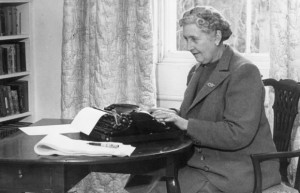Helene Hanff – a love affair
Thanks to Simon at Stuck in A Book, I was reminded of my long-time love affair with Helene Hanff -a lesser-known author who has achieved cult status among bibliophiles. Ms. Hanff was a hard working writer–she wrote essays, television screen plays, magazine articles and industry trade publications –most anything to pay the rent. She was also witty, intelligent and incredibly well read. She put her love of literature, London and New York City into her wonderfully captivating writing. Her books are just plain terrific, based on her own experiences — no fiction necessary here — and none will take you long to read. I believe all are well-worth a permanent place in your personal libraries.
+++++++++++++++++++++++
Ms. Hanff (and yes she would have insisted on ‘Ms’) is most famous for her book 84 Charing Cross Road, which I have read and re-read so many times I had to buy myself a new copy. 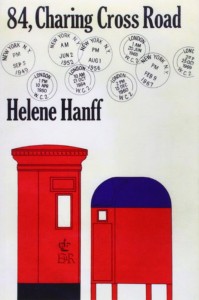 In case you don’t know of this book – it is must reading for any bibliophile. It chronicles the 20-year correspondence between Ms. Hanff and a London antique bookshop located at 84, Charing Cross Road. Ms. Hanff writes to this bookshop seeking various English literature titles in nice affordable volumes. To her delight, she receives not only affordable, but beautifully bound antique editions of her requests — “so fine they embarrass my orange-crate bookshelves”. The letters back and forth over the years are funny, warm and sometimes heartbreaking. The correspondence captures not only the shared love of literature, but family news, dental woes, wartime shortages (she sends the shop food packages during war rationing years) and finding book treasures at English estate sales. The book was made into a 1986 film which did a passable job of portraying the characters and the premise. It stars Anne Bancroft and Anthony Hopkins so you won’t be wasting your time. Remember tingle books? 84, Charing Cross is on my top 10 list.
In case you don’t know of this book – it is must reading for any bibliophile. It chronicles the 20-year correspondence between Ms. Hanff and a London antique bookshop located at 84, Charing Cross Road. Ms. Hanff writes to this bookshop seeking various English literature titles in nice affordable volumes. To her delight, she receives not only affordable, but beautifully bound antique editions of her requests — “so fine they embarrass my orange-crate bookshelves”. The letters back and forth over the years are funny, warm and sometimes heartbreaking. The correspondence captures not only the shared love of literature, but family news, dental woes, wartime shortages (she sends the shop food packages during war rationing years) and finding book treasures at English estate sales. The book was made into a 1986 film which did a passable job of portraying the characters and the premise. It stars Anne Bancroft and Anthony Hopkins so you won’t be wasting your time. Remember tingle books? 84, Charing Cross is on my top 10 list.
+++++++++++++++++++++++
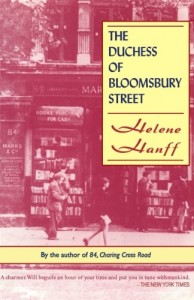 The Duchess of Bloomsbury Street chronicles Ms. Hanff’s experiences in London after the publication of 84, Charing Cross Road. She finally makes her first long overdue trip to London and meets her friends from the bookshop, as well as her fans. Taken completely by surprise, Ms. Hanff and her book are
The Duchess of Bloomsbury Street chronicles Ms. Hanff’s experiences in London after the publication of 84, Charing Cross Road. She finally makes her first long overdue trip to London and meets her friends from the bookshop, as well as her fans. Taken completely by surprise, Ms. Hanff and her book are
celebrities in London. Here she tells of this once-in-a-lifetime trip where she is treated to a whirlwind of introductions, dinners, teas, tours and finally seeing her precious London.
+++++++++++++++++++++
 If you’re going to New York City, live there, or just love the city from afar, you need to find yourself a copy of Letter From New York.
If you’re going to New York City, live there, or just love the city from afar, you need to find yourself a copy of Letter From New York.
From the back cover: From 1978 to 1984, Hanff ( 84 Charing Cross Road ) recorded a five-minute broadcast once a month for the BBC’s Woman’s Hour about her everyday experiences as a resident of New York City.
Here you’ll meet her friends, neighbors and fellow apartment-house dwellers. She describes free concerts, out-of-the-way city parks, her favorite neighborhoods, people and dogs. This is Ms. Hanff’s New York City – sweetly old-fashioned, intimate and never pretentious.
++++++++++++++++++++++
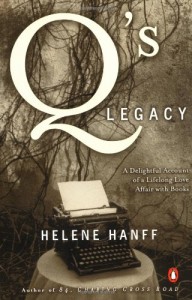 Ms. Hanff was unable to finish her college education, she simply ran out of money. So she decided to educate herself at the public library by working her way through English Literature A to Z. Q’s Legacy chronicles how she discovers Sir Arthur Quiller-Couch –the infamous Cambridge Dean of English Literature and his book “On the Art of Writing”. Reading “Q” spawns a long reading list which now includes English lit classics from Milton, Newman and Walton. Ms. Hanff is unable to find affordable or attractive copies in NYC bookstores. Then one day while reading The Sunday Review of Literature, she spots an advertisement for a bookshop in London …and so the story loops back to the genesis of 84, Charing Cross Road.
Ms. Hanff was unable to finish her college education, she simply ran out of money. So she decided to educate herself at the public library by working her way through English Literature A to Z. Q’s Legacy chronicles how she discovers Sir Arthur Quiller-Couch –the infamous Cambridge Dean of English Literature and his book “On the Art of Writing”. Reading “Q” spawns a long reading list which now includes English lit classics from Milton, Newman and Walton. Ms. Hanff is unable to find affordable or attractive copies in NYC bookstores. Then one day while reading The Sunday Review of Literature, she spots an advertisement for a bookshop in London …and so the story loops back to the genesis of 84, Charing Cross Road.
++++++++++++++++++++++
 Here’s a photo of the bookshop – Marks & Co.
Here’s a photo of the bookshop – Marks & Co.
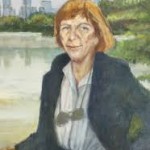 And a portrait of Ms. Hanff – her favorite.
And a portrait of Ms. Hanff – her favorite.
Ms. Hanff passed away in 1997 – poor and without any surviving relatives. Her NY Times obit HERE.
I think that somehow she must know her books are beloved, re-read and cherished by many a book lover.
The Summer Guest by Justin Cronin
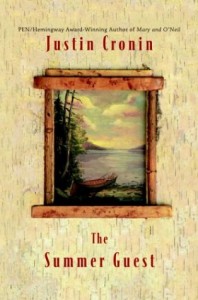 A question for my fellow book lovers: When you’ve just finished a truly moving book do you — like me, close the book, gaze lovingly at its cover, then exhale and hug it to your chest for a few moments? No? Really? OK it must be my own little book barmy quackery.
A question for my fellow book lovers: When you’ve just finished a truly moving book do you — like me, close the book, gaze lovingly at its cover, then exhale and hug it to your chest for a few moments? No? Really? OK it must be my own little book barmy quackery.
The Summer Guest was just such a hug-worthy book. An exceptionally beautiful novel which moved me to tears, laughter, and pure delight. The characters and setting were so real — so authentic, that when I’d lay the book aside — I had to take a moment to clear my head in order to resume my real life.
I’ve had this lovely book on my shelves for years (this is the 2005 paperback edition) and during a recent grey and foggy weekend I roamed my shelves looking for something “summery” to read…and chose this.
(Side note: This is how I justify my not-yet-read book hoarding collection — it is a true pleasure to wake up in my favorite PJ’s and with tea cup in hand, browse through my very own bookshelves and pick out just the perfect book for my mood and the San Francisco weather.)
However, The Summer Guest is not a lightweight summer beach book. This is a complex story of a family over time, children and their parents, love and loss — all told simply and beautifully .
In Mr. Cronin’s spare but expansive novel we begin in 1947, aboard a train chugging through a snowy Maine night and end up in 1997 on a tranquil late-summer evening lake, aboard an old wooden rowboat. Included in between — the living, loving and loss of a family united by a remote Maine fishing camp with an expansive fish-rich lake – “lovely in its pure beauty of having been forgotten”.
“the camp held a ninety-year lease from Maine Paper for two hundred acres rimming the lake to the north and west … I didn’t know exactly where the lines fell, but I didn’t have to. It was so much land it didn’t matter.”
There are the obligatory rutted roads through the deep Maine woods to get to the camp, the idyllic rustic cabins, with fireplaces and creaky porches. The days are filled with early morning coffee with the loons, the intricate symphony of fly fishing and home cooked evening meals in the communal dining room. You can smell the pine trees, baked beans and wood smoke.
The title and the main story line refers to Harry — a guest who has been coming to the camp for many years and is now an old and dying man. Different characters narrate each chapter and tell the past and present story from their individual viewpoints. So there’s also Jordan, a local loner who has become fishing guide and winter caretaker of the camp. Then there are the long-time owners of the camp, Joe and Lucy who have an enviable inner strength and warmth.
Mr. Cronin knows the area and has rendered the voice of his story through dry and acerbic Maine eyes:
“He gave me a curt nod from the chin, the North Woods equivalent of a full body hug.” and then this,
“this was an inbred town in northwest Maine where, as we said, half the people spoke French and the other half yelled.”
When Jordan, the local fishing guide takes out a group of big city lawyers, the author deftly captures the inevitable situation.
“By this point Bill had actually managed to get his fish under control and was thrashing around in the shallows, his rod hand held high over his head to keep the line tight while, with the other, he made unsuccessful, scooping lunges with his net. Done properly, this can be one of the most satisfyingly graceful moments in the sport, but in Bill’s case it was like watching a man trying to hail a taxi while simultaneously chasing a piece of blowing litter down the street.”
Mr. Cronin has precisely penned the words to express emotions we have all felt — from mournful sections which wrap the reader into the characters’ brave sadness and loss – to the exquisite joy of first love…
“…the thought of Kate was suddenly woven like a thread through everything, all that had ever happened to me, the clean smell of the pines and the lake and the memory of my lonely winters, the very turning world we stood on. They say that the moment your life appears before your eyes will be your last, but I’m here to say that it’s not so very different when you kiss a woman like Kate, whoever your Kate may be.”
The scene where the summer guests are dancing on the dock to Ella Fitzgerald is so beautifully told it will bring tears to your eyes.
Justin Cronin paints a beautiful picture of this remote Maine camp where the summers of deep woods and deep lakes come alive on the pages — “enough silence to let you hear the planet spin or make you mad if you thought too long about it.”
The Philadelphia Inquirer called The Summer Guest — “A work of art, Justin Cronin has written a great American novel.”
That captures it perfectly. I can only add it’s a must read (and a must keep on my shelves) novel. I highly recommend it.
French Dirt by Richard Goodman
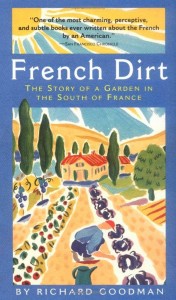 Richard Goodman saw the ad in the paper: “SOUTHERN FRANCE: Stone house in Village near Nimes/Avignon/Uzes. 4 BR, 2 baths, fireplace, books, desk, bikes. Perfect for writing, painting, exploring & experiencing la France profonde. $450 mo. plus utilities.
Richard Goodman saw the ad in the paper: “SOUTHERN FRANCE: Stone house in Village near Nimes/Avignon/Uzes. 4 BR, 2 baths, fireplace, books, desk, bikes. Perfect for writing, painting, exploring & experiencing la France profonde. $450 mo. plus utilities.
And so, with his girlfriend Iggy, he leaves New York City to spend a year renting a two hundred year old stone house in Southern France. Located in a small village fictionally called St. Sebastien de Caisson, it doesn’t have a cafe, store or even a post office. Starry-eyed, Richard and Iggy soon discover they are having a tough time connecting with the locals. Out of necessity, Richard works in a vineyard in exchange for firewood. In the vineyard, he forms a solitary friendship with Jules, a handsome 25 year old, and through that relationship Richard borrows a small plot of land. Having a difficult time making friends in his little village, Richard determines to make a vegetable garden instead.
Oh no, you say, not another “my experiences in France book” — trust me, this one is different — part travelogue, part gardener’s journal, part pilgrimage and wholly enjoyable. I read French Dirt when it was first published in the 90’s and remember it fondly. It has recently been republished with a pretty new cover (shown here) and when I picked it up in the bookstore, I remembered I still had my copy lurking in my towering chaos collection of books. I dug out my older copy (Yes, I knew right where it was – I’m a “rainman” when it comes to locating my books) and re-read French Dirt over the last two evenings.
What sets this tale apart from the plethora of “my life in France” books, is that Richard is such a hapless American on so many levels. His plans for his garden, forming friendships with the locals, and settling in to a new life often go awry. You chuckle and wince as he binge-buys plants and tries to sort out conflicting advice from the villagers — but then you cheer as he toils and worries over his garden, delights in its growth and is distraught by his garden disasters — all while the neighbors politely hide their amusement at the silly American.
It’s not all fun and games, there is quiet despair as Richard struggles to master the ancient house repairs and loneliness when they are housebound during an endless number of rainy days. But as his garden grows, slow friendships also develop. There is a heart-warming and funny description of a prank in which one of the least likely villagers secretly places perfect red, ripe tomatoes in his garden in early June.
Happily, the book does not parody the villagers — there are no caricatures of French people – they are treated gently and with respect in this memoir. And while Richard struggles and fails, he never feels sorry for himself or blames others. He is open and honest with his own shortcomings. Richard is also serious and perhaps even somber as he recounts the backbreaking hours in the brutal Southern French sun — all for a beloved garden which he knows he must abandon at the end of the year.
He writes; “I would crouch down on one knee, thrust my hand shovel in and turn the earth up and over, revealing its darker, humid underside. Then I would crumble it slowly in my hands to better allow the plant to breathe. In that sense I had a comradeship with the earth: I must be able to breathe, too.”
No question that this is a “gardener’s tale” — if you are not interested in gardens or gardening – this may not be a book for you. And admittedly, the writing is often far from perfect, but you won’t mind as Richard’s story is heartfelt and true.
French Dirt is a gentle adventure of sorts — the American as an immigrant and the searching for a new identity in an old place. If like me, you ever daydream, even just a little bit, about moving to a foreign country – this is a perfect afternoon-in-the-hammock summertime read.
Signs That Agatha Christie Is About To Murder You
Courtesy of Beulah Maud Devaney of The Toast
In your previous life you were a medical practitioner and accidentally killed a patient while drunk. Since then you have stopped drinking, changed your name to something with the same initials as your previous name, and moved within 5 miles of the original murder. You have also married the dead patient’s spouse.
You have received a letter from a recent murder victim. You read half of it before stopping to inform your guests and entire staff about the letter. You then wander off to read the rest in your study, next to your collection of antique blowpipes.
At dinner you decide to tell a lighthearted story about a gruesome murder. The murderer escaped but had an unusual physical defect by which you would be able to identify them anywhere. You refuse to disclose any more details but glance meaningfully around the table before heading up to bed.
You noticed something odd at dinner but can’t work out what it was. You informed the table of this and then wandered off to the summer house for a nap.
You began life as a homeless street urchin but, in a vulgar retaliation against your social position, you built your own business empire and now own all of New York.
You have a dazzling cousin with a boy’s name who wears short dresses and enjoys midnight swimming with your fiance. She appears to be in danger of being murdered. You have invited her to stay with you.
You are surrounded by foreigners.
You have a maid called Hilda, Tilda, Greeta, or Gretel who you are horrible to. She has ugly glasses and watchful eyes.
You suspect that a murder has been committed so you tell no one and invite the murderer to dinner.
You have a much younger husband. You met him on a cruise just two weeks after your husband died. Your family doesn’t like his paintings.
Your husband has died after drinking a poisoned cup of tea that only you and one other person could have prepared for him. You continue to doggedly drink tea and claim the whole thing is a misunderstanding.
You are a handsome woman.
You agreed to divorce your wife months ago, but she keeps sending detectives to ask you for a divorce and some of your personalized writing paper is missing.
You organize a big family gathering and use it to insult all your guests. You then whip out your will and alter it at the dinner table while everyone finishes their semolina pudding.
Your mousey little wife is extremely unattractive (those glasses! that schoolgirl bob!) but also bears a passing resemblance to the glamorous film star you are having an affair with.
Worried that your past is catching up with you, you have decided to fake your own death with the use of a dead tramp.
You receive a vaguely lewd poison pen letter and decide to have a bridge party to celebrate.
One of your neighbours accidentally donated a priceless work of art to the vicarage jumble sale. You brought it on a whim and are now drinking tea beneath it.
You are traveling to meet your young lover when you notice your estranged husband getting on the same train. You assume last night’s ugly scene (where you told him about Alfredo’s sensuous spirit) has been forgotten and he is taking a spontaneous business trip.
You insist on dropping hints to your guests about Bunny’s “frightfully interesting time during the war.” Bunny is glowering.
You are being blackmailed by a swarthy fellow. Rather than give in to his demands you make a speech about good old England and then turn your back to write a note to your tailor.
You habitually wear dark glasses, big hats, false teeth, bulky coats and speak with a unique yet easy to mimic accent. All of your friends, family and staff used to be on the stage.
Everything tastes horrible.
Everyone hates you.
The Postage Stamp Vegetable Garden by Karen Newcomb
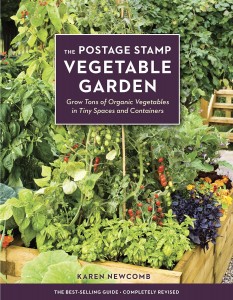 What, you say — a gardening book? Who sits down and reads a gardening book? True confession time, I do. This guide turned out to be ideal for my city-small garden and my raised vegetable growing beds.
What, you say — a gardening book? Who sits down and reads a gardening book? True confession time, I do. This guide turned out to be ideal for my city-small garden and my raised vegetable growing beds.
The book opens with this great passage:
It’s a beautiful day. There’s not a cloud in the sky. The temperature is in the mid-80s. And there you are in your backyard, picking loads of vegetables from your own small garden tucked away in the corner of your property. Tomatoes, onions, corn, beans, you’ve grown them all—in fact, more than you ever dreamed possible from such a small space.
Impossible?
Of course not. That’s exactly what a postage stamp garden is intended to do and what you will learn to do in the next several chapters. The techniques outlined here allow you to double or triple the quantities of vegetables you might normally grow in any given space.
First published 40 years ago, in this newly revised edition, Ms. Newcomb introduces us to a radical style of gardening tailored for “postage stamp” or small space gardens. She advocates planting seeds much closer than recommended on the seed packets, with no neat rows and succession plant so you have crops all year round (depending on your location).
She goes on to explain the history of this technique.
The history of this incredible gardening system began in the 1890s. Outside Paris, a few enterprising Frenchmen began raising crops using a new method they discovered. Over their land they spread an 18-inch layer of manure (plentiful in the day of the horse and buggy) and planted their vegetables so close together in this rich material that the leaves touched one another as the plants grew. Under this carpet of leaves, the ground remained moist, warm, and vigorous. During periods of frost, they set glass jars over the tiny plants to give them an early start. So good were the Frenchmen in devising fresh ways of growing things that they were able to produce nine crops a year. Such was the birth of the French Intensive method of gardening, an early form of what we now call intensive gardening.
The benefits of this technique, besides year-round vegetables, are quite attractive — you need less water (key here in California) and it requires less weeding (hear-hear!). Not to say that postage-stamp gardening doesn’t have it’s challenges – it does — but they are clearly and simply explained in this book.
She makes it easy to understand her concept of “crop stretching” — that is, when succession planting in an area that has frost and winter (poor you) you should alternate your crops – early spring planted crops (spinach) are replaced by later crops (beans). Also, if you’ve just harvested slow-growing crops (broccoli) in late summer you now have a short growing season left, so plant a quick maturing crop such as green onions. If your garden is in a temperate climate (like mine) you can plant the same crops in succession all year long (as with lettuce or spinach). She goes on to explain “intercropping” — planting quick maturing crops between slower maturing crops. You harvest the intercrops before the maturing crops have grown big enough to crowd the smaller plants out. That’s getting double duty out of your postage stamp bed.
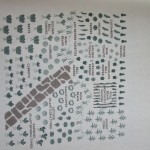 The author has given detailed drawings of sample garden layouts, (sorry for the poor photo) there are several designed to fit a 4×4 bed. Look at all the produce! Click to make larger.
The author has given detailed drawings of sample garden layouts, (sorry for the poor photo) there are several designed to fit a 4×4 bed. Look at all the produce! Click to make larger.
The last half of the book is filled with a vegetable by vegetable guide – Ms. Newcomb recommends heirlooms and gives a cute little postage stamp rating (1 to 4 stamps) to indicate which are best for postage stamp gardens. And each section gives crop stretching advice — “you can follow beans with a planting of cabbage…”
There are additional sections covering: Plants That Like Each Other; Herbs; Companion flowers; Composting and Pest Control.
After reading this book, I felt like a beginning gardener all over again. Turns out I’ve been doing it all wrong — plant my vegetables once (or twice) during the year, always in neat rows, thin the small seedlings, and rejoice over what now appears to be very paltry results.
So, if you have a small garden or don’t want the work of a larger one, this is the book for you.
Now, if you’ll excuse me, I have seeds to plant.
The novels of Nicole Mones
Overheard in the bookstore the other day:
“Have you read this? It’s wonderful.”
“I don’t read novels, when I read I want to learn and educate myself.”
I’ve heard variations on this opinion before from smart and respectable non-fiction-only readers and I always nod and smile. In truth, however, I have to quell the urge to grab them by the arm, march them into a comfortable chair, give them a cup of coffee and demand they read an author such as Nicole Mones.
A newly launched textile business took Nicole Mones to China for the first time in 1977, after the end of the Cultural Revolution. She traded textiles with China for eighteen years before she turned to writing. Ms. Mones’ extensive knowledge of China’s culture, history and politics is woven throughout her books. Her novels are enthralling, but each one is an education as well. Ms. Mones is an author who obviously understands that there are readers who want to think and be entertained at the same time.
++++++++++++++++++
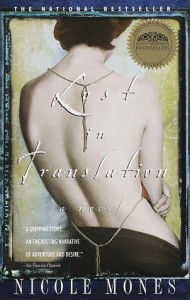 Lost In Translation, Ms. Mones’ debut novel takes the reader into the world of Alice, an unlikeable American woman living in contemporary China. Alienated from her Congressman father because of his overt racism, Alice seeks to leave America behind and become Chinese. She works as a translator by day and secretly haunts bars at night often having one night stands with Chinese men – trying to understand and connect with the xenophobic culture.
Lost In Translation, Ms. Mones’ debut novel takes the reader into the world of Alice, an unlikeable American woman living in contemporary China. Alienated from her Congressman father because of his overt racism, Alice seeks to leave America behind and become Chinese. She works as a translator by day and secretly haunts bars at night often having one night stands with Chinese men – trying to understand and connect with the xenophobic culture.
But things change for Alice when she accepts a translator position with an archeological team tracking the remains of the ancient and important Chinese treasure — “the Peking Man”. Alice becomes close to Lin a member of the team, while they navigate mysterious secret meetings and the threat of arrest. Working with Lin, she forms a close connection and better understanding of Chinese culture and history
The novel not only mesmerizes with the fictional characters and storyline, but goes further to weave in the historical significance of Peking Man as the first ancestor of China and the important writings of the French Jesuit priest-philosopher, Tielhard de Chardin, from whom the archeological team gains clues as to the whereabouts of the bones. This novel has it all – an engrossing mystery combined with Chinese cultural history and a dash of sex and romance.
The title* captures the gist of the novel, namely the difficulties of trying to move between cultures, language, history and current society — never being sure what has been lost in translation. (*No relation to the Bill Murray film of the same name.)
+++++++++++++++++++++++
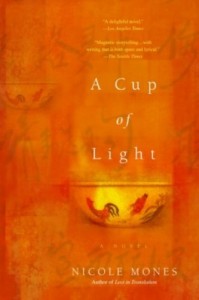 A Cup of Light transports us into the rarefied world of Chinese porcelain “pots” long treasured by emperors and collectors alike.
A Cup of Light transports us into the rarefied world of Chinese porcelain “pots” long treasured by emperors and collectors alike.
Lia Frank is an American appraiser of fine Chinese porcelain and is sent to Beijing to authenticate a collection of rare pots going up for international sale. As she unpacks the crates, holding each delicate piece and “feeling” the refined porcelain, she discovers there are many more pots than originally estimated and that some of them are “fakes”. But these are no ordinary fakes –these are forgeries so exquisite, so precise that she has to find the forger. In Chinese culture when the copy is as beautiful as the piece it imitates then the forgery and the forger are greatly admired.
Again an education here — with A Cup of Light you’ll discover the infamous Chenghua Chinese cups, visit the town of Jingdezhen where the truly priceless pots were manufactured for the emperors and learn how these pots were hidden and smuggled out (with some lost) during the 1931 Japanese invasion. Also, if you’re like me you’ll cringe in embarrassment as you learn that J.P. Morgan (yes that J.P. Morgan) tried to buy the entire contents of the Forbidden City in 1913 for twenty million dollars – so many of the priceless and culturally important pots were buried and hidden. Luckily, old J.P. died and the deal was abandoned.
Lia wears hearing aids and takes them out to achieve complete silence to exercise her memories. Lia is a mnemonist and has memorized not only every pot she has ever examined, but also every catalog and history. She uses the Greek/Roman mnemonic system to memorize and at first I found it unbelievable, but with a little research I found it was actually a real thing. Ms. Mones also based this on the real missionary Matteo Ricci who taught young Chinese scholars tricks to increase their memory skills–an important advantage in a nation with countless laws and rituals which had to be learned by heart. But I digress, when Lia goes into her memory files to help her determine which pot is real or fake, we get some fascinating Chinese porcelain history. Also fascinating is the current day political intrigue intruding into Lia’s world of beautiful pots contrasted with her researching (remembering) similar shadiness throughout the history of Chinese porcelain.
Ms. Mones was a textile trader in China for many years and her knowledge of the underworld of art smuggling and forgeries shines through. In each of her novels, the lead female characters have many flaws, but Ms. Mones always portrays them as competent, professional women with real work to accomplish.
+++++++++++++++++++++++
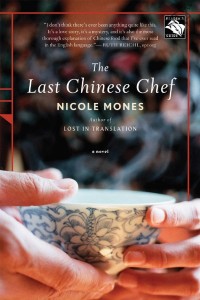 The Last Chinese Chef is probably my favorite of her novels. This time, Ms. Mones, a contributor to the now sadly defunct Gourmet magazine, takes us into the luscious world of Chinese cuisine.
The Last Chinese Chef is probably my favorite of her novels. This time, Ms. Mones, a contributor to the now sadly defunct Gourmet magazine, takes us into the luscious world of Chinese cuisine.
When Maggie McElroy, a widowed American food writer, learns of a Chinese paternity claim against her late husband’s estate, she has to go immediately to Beijing. She asks her magazine for time off, but her editor counters with an assignment: to profile the rising culinary star, Sam Liang, who is about to open an imperial-style restaurant in Beijing. When the restaurant opening is delayed Sam, who is half Chinese, half American, acts as Maggie’s translator and helps her track down the child and unravel the mystery of the parentage.
But readers – it’s the backdrop of the FOOD that is the heart and soul of this novel.
We understand the intricacies of Chinese cuisine. The concepts of texture and appearance are as important as flavor on the Chinese table. We learn about “guanxi” — the Chinese concept of relationships. We see that food is at the heart of Chinese relationships, one reason why all meals are shared in China and never individually plated. Chinese cuisine is very much about presentation including symbols and references which are understood instantly and connect its people not only to one another but to their culture and history.
This is not to say that the characters or the plot of The Last Chinese Chef aren’t compelling — oh they are. Sam, the heir to the family’s cooking expertise, is sexy yet gentle – helping Maggie comprehend the often mystifying Chinese culture and re-awakens her interest in food by preparing her luscious dishes (I know… sigh). Sam decides to enter a Chinese cooking competition and we watch, smell and taste the tapestry of the food he prepares to practice. Sam’s grandfather, Liang Wei, had been one of the last generation of chefs in the Forbidden City and the author of a highly regarded tome on the art of Chinese cuisine. Each chapter of the book starts with quotes of wisdom from this fictional but very realistic Chinese cook book. Eventually, Maggie and Sam unravel the truth behind the child’s parentage, but by then Maggie doesn’t care so much, re-awakened from her grief and happily eating.
+++++++++++++++++++++++
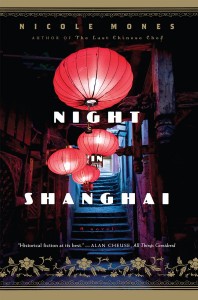 Night in Shanghai is Ms. Mone’s most recent novel. I haven’t read it, but it’s next on my list.
Night in Shanghai is Ms. Mone’s most recent novel. I haven’t read it, but it’s next on my list.
It’s about the little-known story of black musicians in the Chinese jazz age. You can watch the book’s trailer HERE.
(Who knew that one day book publishing/marketing includes film-style trailers.)


